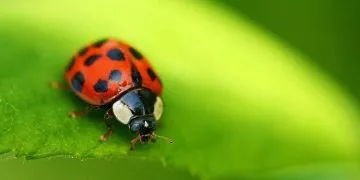Over 350 million years ago, dragonflies first started to zip around ponds, marshes, and other bodies of water.
This prehistoric insect belongs to the Odonata family, along with their closely related cousin-insects, damselflies.
There are over 3,000 known dragonfly species living on nearly every continent in the world.
Here we’re going to explore 15 awesome facts about dragonflies that you probably didn’t know!
Damselflies are often confused with dragonflies.
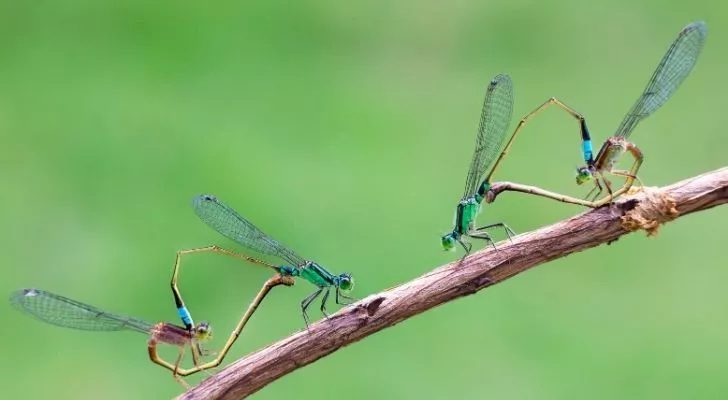
The Odonata family of insects only has two main species, the dragonfly and damselfly.
Most people will confuse the two at first glance, as they are very similar in appearance as a whole.
The key to identifying them is in their wings. A dragonfly has four wings, while a damselfly only has two.
When a dragonfly rests, they spread their wings out horizontally, whereas damselflies tuck their wings in against their bodies.
Another indicator is their eyes. All damselflies’ eyes are separated, while most dragonflies’ eyes are together.
Dragonflies are older than dinosaurs.
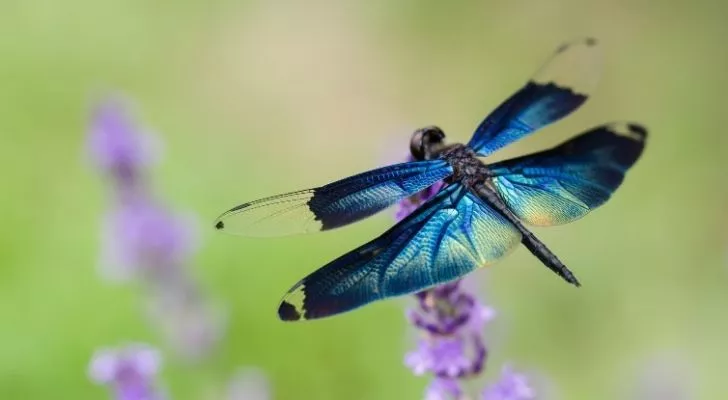
If you were to go back about 300 million years ago, you’d likely come face to face with the ancestors of dragonflies, meganisoptera (sometimes referred to as griffinflies).
This long-extinct relation of the dragonfly lived from 323 million to 250 million years BC during the Paleozoic era.
The vast majority of griffinflies were a similar size to their modern cousins. However, one species called the megatypus would most likely scare the living daylight out of you if you were to encounter it.
The clue is in the name, as the megatypus grew to an alarming size, with a wingspan up to 28 inches (70cm)!
Dragonflies can be found worldwide.
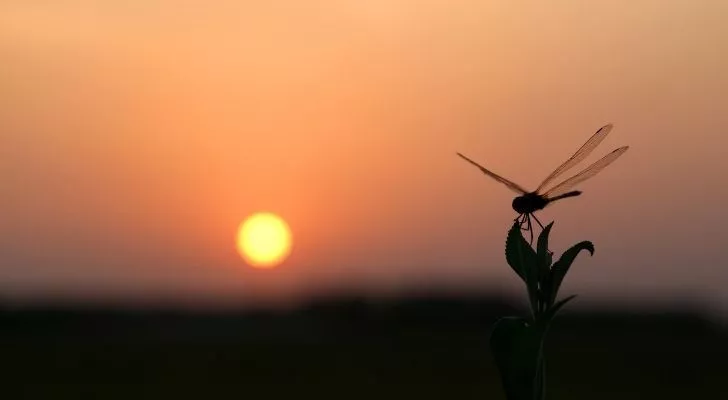
Different species of dragonflies can be found in almost every corner of the world.
Most of them tend to stay within one select area, but there are a few which are a little more widespread.
The emperor anax, for example, can be found throughout the Americas, from the southernmost tip of Argentina all the way up to Newfoundland in Canada.
More impressive, though, is the globe skimmer dragonfly, which can be found in the warmer regions of every continent in the world, except Antarctica.
Dragonfly larvae live underwater.
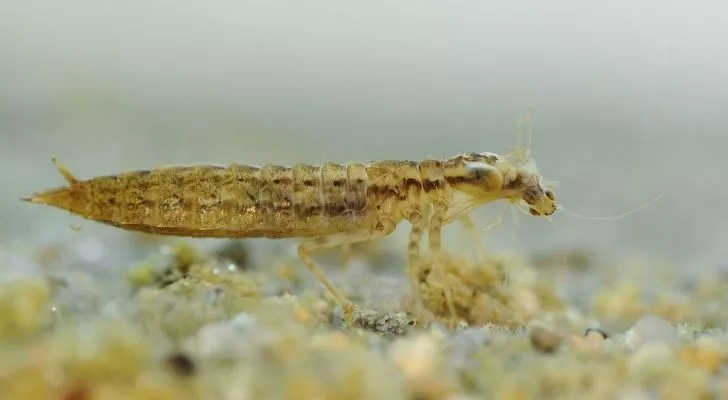
The biological term for invertebrate insects during the stage in which they go through the process of metamorphosis is nymphs.
Some examples of such insects are grasshoppers, cicadas, and dragonflies.
Referring to dragonfly larvae as nymphs is particularly fitting, though. In mythology, a nymph is a type of spirit that lives in rivers, streams, and other such areas.
Just like their mythological counterparts, dragonfly nymphs live underwater.
Adult dragonflies lay their eggs in the tissue of aquatic plants or on the surface of the water. After hatching from their eggs, the nymphs spend several years underwater, feeding on other invertebrates, tadpoles, and even small fish.
Dragonflies are incredibly skilled in flight.
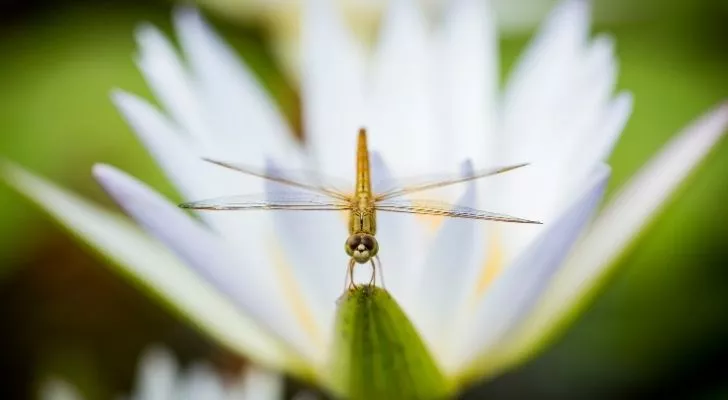
If you’ve ever spent a lazy day by a lake, then you probably know what I mean. Dragonflies’ flying abilities are so great that they’re known to even migrate across seas!
They can move in any direction (yes, they can even fly backward!), and are capable of changing direction in an instant, almost pivoting on the spot.
Their wings are so powerful that they have been recorded flying up to speeds of 22-34 mph (36-54 km/h)!
There are old reports of an Australian species called the southern giant darner reaching speeds up to 60mph (97 km/h).
Although these reports aren’t held to be true as the speed has not been recorded since 1917.
Dragonflies can control all four wings independently.
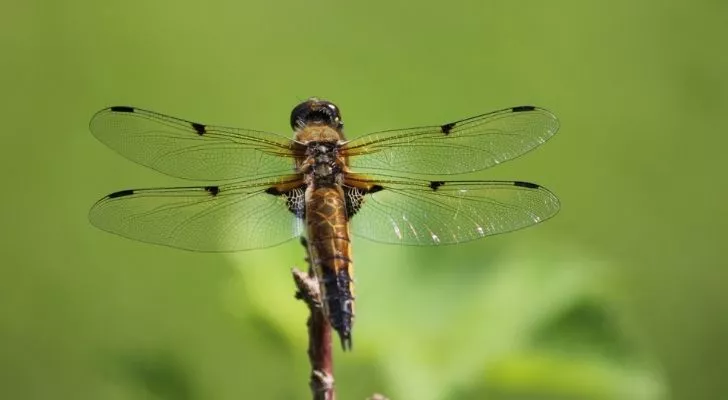
One of the main reasons dragonflies are so skilled in flight is due to their wings. They can beat all their wings independently, and through this method, have four different methods of flight.
Dragonflies can hover like helicopters, fly staggeringly slowly or as fast as an arrow, and even change direction on a pin by beating all four wings in sync with each other.
They can also free-glide, with some females gliding behind males while mating mid-flight!
Dragonflies are some of the most efficient hunters in the world!
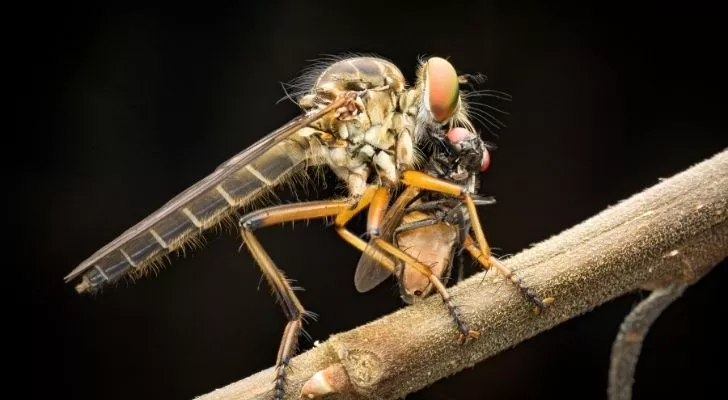
Adult dragonflies are predators, living off an almost exclusively carnivorous diet based on other insects such as mosquitoes, flies, moths, as well as smaller dragonflies.
Thanks to their speed and agility in flight, they catch their prey with their feet while airborne.
The efficiency of dragonflies’ hunting ability is one of their most remarkable traits, though, as they are able to catch up to 95% of all prey they choose to hunt.
When they do catch something, they immobilize it by biting its head. They then usually perch somewhere and enjoy their meal on the spot, but they can also eat while on the move!
Their incredibly powerful jaws make short work of their prey, most commonly starting head first!
Dragonflies are calculated killers.
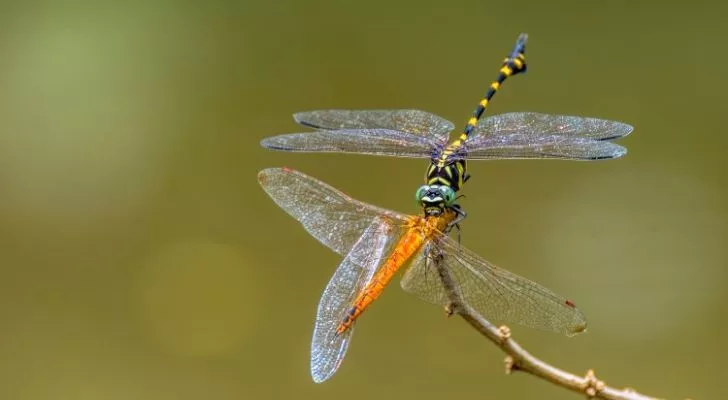
When hunting, dragonflies don’t simply hunt down an insect by tracking its movement and out-winging it.
Instead, they do something quite similar to what we as humans are capable of – they intercept their quarry.
To do this, they have to calculate not only the speed that their prey is going at but where it is going and how far away it is.
They’re capable of doing this in microseconds and zoom off to where their prey is going to be, not where it is, to catch it.
Dragonflies are capable of camouflaging themselves mid-flight!
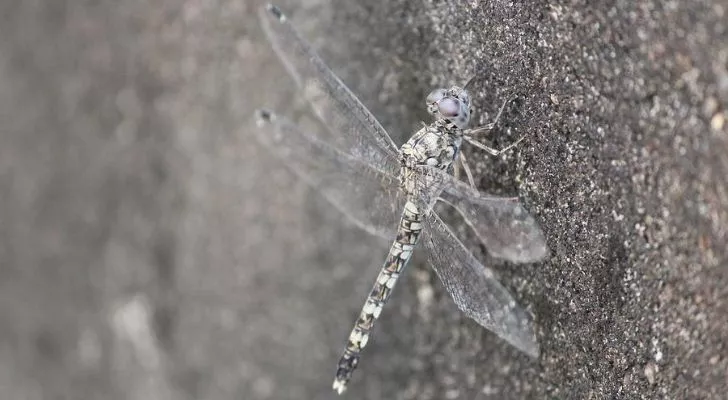
A certain species of dragonfly called the Australian emperor dragonfly has been recorded to use a method called motion camouflage during territorial fights with other male dragonflies.
To put it simply, they fly in a certain direction to appear as if they aren’t moving at all.
This is simply an illusion, though, as they are actually moving rapidly towards them.
It works by moving in such a flight path so that it is always in a position between the target and the location that it started attacking from.
Dragonflies have long been considered evil in Western culture.
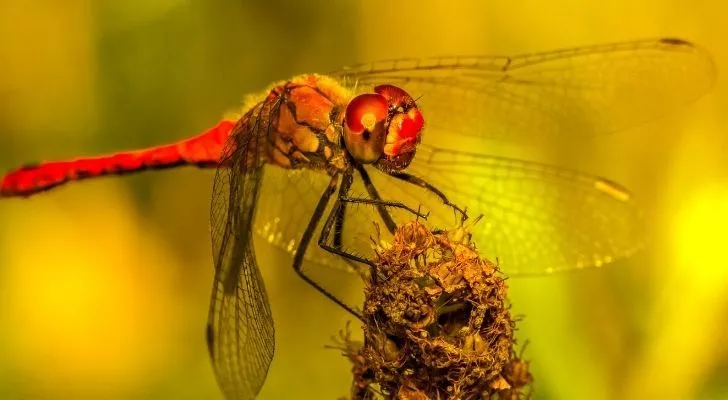
Dragonflies have many names across Europe, yet all of them tend to attribute some kind of evil or sinister aspect to them.
The Norwegian name translates into “eye-poker,” and the Portuguese name translates into “eye-snatcher.”
The most horrific of them all comes from North America – the “devil’s darning needle.”
A darning needle is a large, blunt needle that is used to repair holes or worn areas in clothing or other pieces of fabric.
The legend behind dragonflies being called devil’s darning needles comes from the idea that dragonflies would sew up the lips of naughty children while they sleep.
Dragonflies aren’t considered to be sinister everywhere, though.
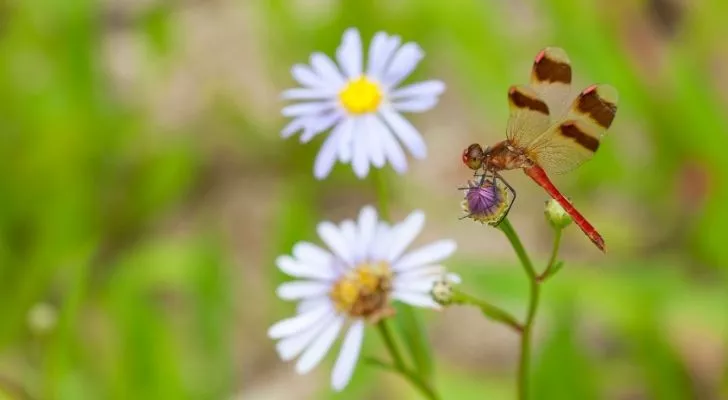
Japanese folklore surrounding dragonflies is a sharp contrast to the way they have been traditionally perceived in the west.
While the west sees them as companions to witches, snakes, and even the devil, Japan sees them as creatures worthy of respect.
They are said to be symbols of courage, success, strength, and even happiness!
Dragonfly eyes are a sight to behold.
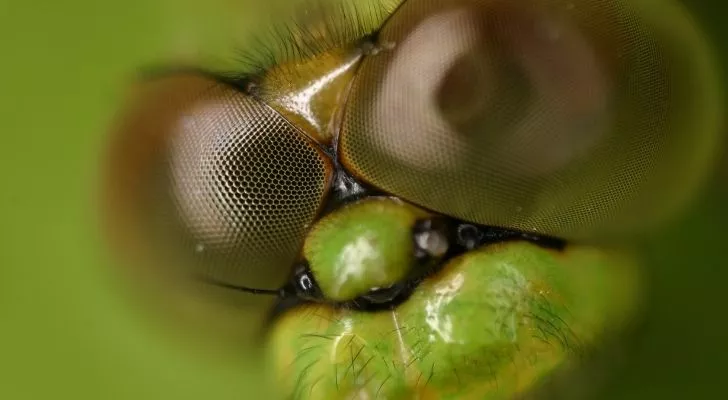
Just like the common house fly, dragonflies have compound eyes. This means that their eyes are actually made up of thousands upon thousands of individual lenses, all taking in information about the surrounding area.
Dragonflies have up to 24,000 such lenses (or facets), which enable them to see nearly 360 degrees. Their only blind spot is directly behind them.
Thanks to their incredible eyes, they’re able to pick out single insects out of a swarm, all the while taking care of their surroundings while flying at high speed!
Some species of dragonflies migrate further than you’d think!
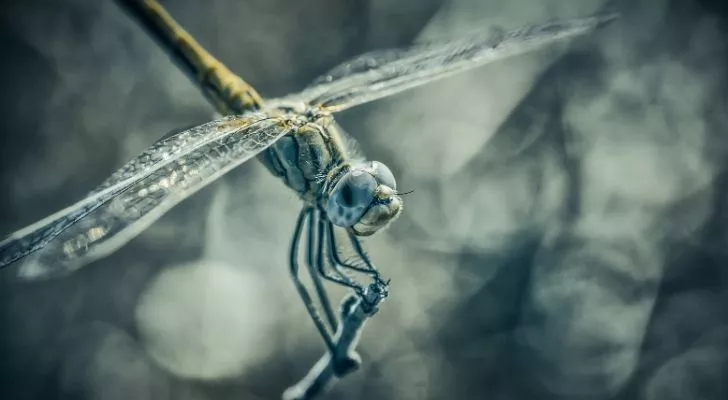
Certain species of dragonflies are known to migrate, generally moving to new locations to spawn their eggs in different ponds or to avoid unsuitable changes in the weather or temperature.
They can either migrate by themselves or in giant swarms.
One example of a dragonfly species that migrate in swarms is the green darner, which heads south to warmer weather over fall, only returning in spring.
Another impressive dragonfly species is the globe skimmer, which has been recorded to migrate up to 11,000 miles (17,702 km) between India and Africa.
Dragonflies can regulate their body temperature.
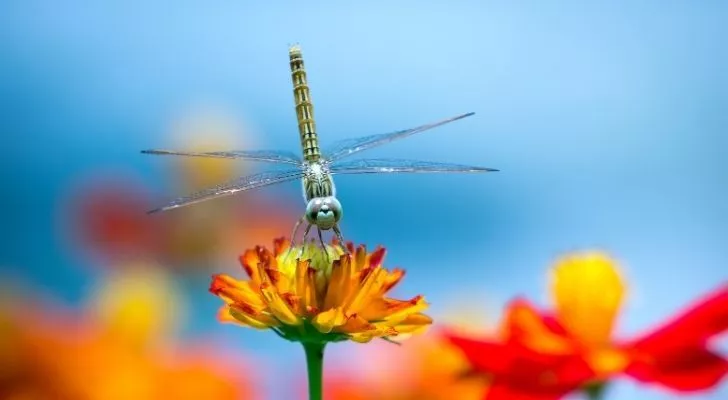
Dragonflies are cold-blooded creatures, which means that their own bodies don’t generate enough heat to sustain themselves.
As such, cold-blooded creatures need to attain heat from their environment. Dragonflies do this by basking in the sun, just like lizards, but this isn’t their only trick.
They’re able to warm themselves up by a process called wing-whirring, where they vibrate their wings at such a speed that it generates heat!
Dragonflies can’t bear the heat!
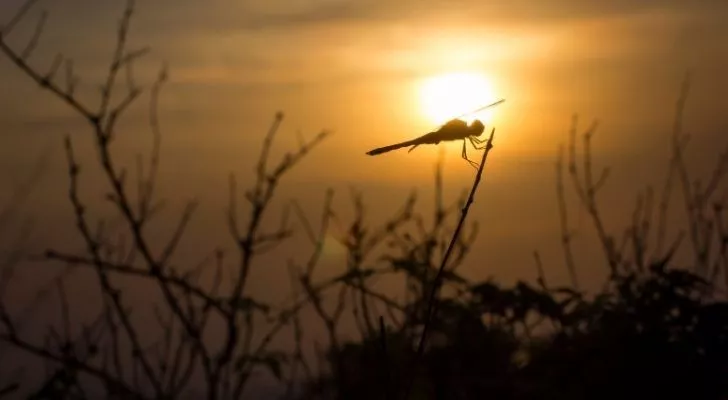
While dragonflies do need to warm themselves up to a certain point, they also need to make sure that they don’t get too hot.
One such tactic that certain species of dragonflies employ to beat the heat is called the obelisk pose.
You may have even seen them doing it and wondered what they’re doing – well, wonder no more!
A dragonfly will go into the obelisk pose by almost going into a handstand and sticking its abdomen high up into the air.
This helps the dragonfly cool down a little by reducing the amount of sunlight hitting its body.
It’s pretty easy to see why there are so many odonatologists (people who study dragonflies and damselflies) worldwide.
The more you learn about dragonflies, the more you begin to marvel at them!
They’re the oldest insect, their vision and flight is unmatched, and they’re pretty damn beautiful too!
Given their extensive history on earth and their incredible abilities, I wouldn’t be surprised if they end up outliving most insects that we know today!





